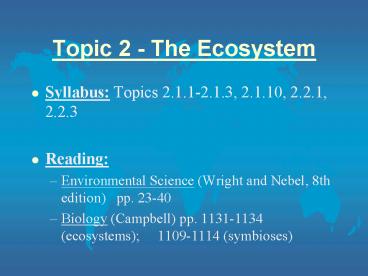Topic 2 The Ecosystem - PowerPoint PPT Presentation
1 / 19
Title:
Topic 2 The Ecosystem
Description:
Quaternary consumer - eats tertiary consumers e.g. killer whale ... Barnacles on whales. More examples. Bacteria in hydrothermal vent tubeworms ... – PowerPoint PPT presentation
Number of Views:106
Avg rating:3.0/5.0
Title: Topic 2 The Ecosystem
1
Topic 2 - The Ecosystem
- Syllabus Topics 2.1.1-2.1.3, 2.1.10, 2.2.1,
2.2.3 - Reading
- Environmental Science (Wright and Nebel, 8th
edition) pp. 23-40 - Biology (Campbell) pp. 1131-1134 (ecosystems)
1109-1114 (symbioses)
2
Topic 2 The Ecosystem
- Ecosystem - a community of interdependent
organisms and the physical environment they
inhabit (IB) - Biotic abiotic components of ecosystems
- Biotic factor - a living, biological factor that
may influence an organism or an ecosystem (IB) - e.g. predation, disease, competition
- Abiotic factor - a non-living, physical factor
that may influence an organism or an ecosystem
(IB) - e.g. temperature, salinity, pH, light
3
Ecosystem structure
- Often described based on feeding relationships
- Species can be divided into trophic levels based
on their main source of nutrition - Trophic level - the position that an organism
occupies in a food chain OR a group of organisms
in the community that occupy the same position in
food chains - The trophic level that ultimately supports all
others consists of autotrophs (primary producers)
4
Producer
- Autotroph - self feed
- An organism that obtains organic food molecules
without eating other organisms but by using
energy from the sun or inorganic molecules to
make organic molecules - Remember this trophic level supports all others
- Role of producers is to convert energy into a
form useable for other organisms
5
- Most producers are photosynthetic (e.g. algae,
mosses, diatoms, some bacteria, plants etc.) but
some are chemosynthetic (e.g. hydrothermal vent
bacteria)
6
Consumer
- Heterotroph - other feed
- An organism that obtains its nutrition by eating
other organisms - Primary consumer (herbivore) - eats producers
e.g. sea urchin, copepod - Secondary consumer (carnivore) - eats primary
consumers e.g. wolf eel, herring - Tertiary consumer - eats secondary consumers e.g.
sea otter, seal - Quaternary consumer - eats tertiary consumers
e.g. killer whale
7
- Role of consumers in an ecosystem is to transfer
energy from one trophic level to the next
8
Decomposer
- An organism that obtains energy by breaking down
dead organic matter (including dead plants, dead
animals and animal waste) into more simple
substances - e.g. bacteria and fungi
- Interconnect all trophic levels since the organic
material making up all living organisms is
eventually broken down - Role of decomposers is to return valuable
nutrients to the system so they can be used again
9
Ecological Niche
10
Food chains and food webs
- Few systems are so simple that they just consist
of an unbranched food chain - Most are very complex as many species feed on
more than one species and some consumers even
feed at different trophic levels resulting in a
food web - Food webs are more complex and therefore more
stable
11
Energy flow through an ecosystem
- An ecosystems trophic structure determines
energy flow and nutrient cycling
Producers
Herbivores
Carnivores
Decomposers
Nutrient Pool
Heat
12
Laws of thermodynamics
- Remember them?
- How do they apply to ecosystems?
- First law - Energy is transferred from one
trophic level to the next, energy is transformed
from light to chemical (photosynthesis) and
chemical to heat (respiration) - Second law - as energy flows through an
ecosystem, much of it is lost at each trophic
level
13
Rainbow trout in Northern Pike
14
Symbiosis
- sym together, bio life
- Relationship between two organisms that is not
necessarily based on feeding - An ecological relationship between organisms of
two different species that live together in
direct contact - 3 types of symbiosis - mutualism, commensalism,
parasitism
15
1. Mutualism
- Interaction between two species where both
benefit - e.g. zooxanthellae in anemones corals nitrogen
fixing bacteria in legumes cleaner fish lichen
16
2. Commensalism
- Interaction between two organisms in which one
species benefits while the other is unaffected - e.g. eyelash mites, orchids as epiphytes, remora
on shark
17
3. Parasitism
- Interaction where one organism benefits while the
other is harmed - e.g. tapeworm in human digestive system leeches
on fish fleas on a dog sea lettuce growing on
bull kelp
18
Other symbiosis examples
- Barnacles on whales
19
More examples
- Bacteria in hydrothermal vent tubeworms
- Plasmodium falciparum (malaria-causing protozoan)
in Homo sapiens - Sea anemone and clownfish































